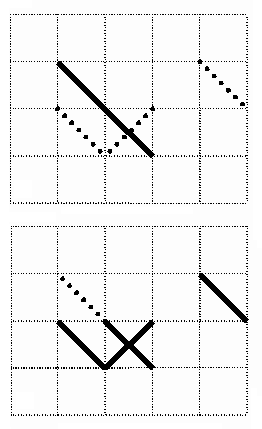| ENG RUS | Timus Online Judge |
1035. Cross-stitchTime limit: 0.5 second Memory limit: 64 MB  Archaeologists have found a cloth decorated with needlework. This needlework is a cross-stitch made with several threads. The following rules have been observed:
On the figure you can see an example of a pattern made with six stitches. The grid has size 4 × 5. The face of the cloth is drawn on the upper half of the figure. The stitches lying on the face are drawn with solid lines. The rear stitches uncovered with those of the face are drawn with dot-lines. On the lower half of the figure the cloth is oriented as on the upper half. All the rear stitches are drawn with solid lines there. The face stitches, which do not cover rear stitches, are drawn with dot-lines. This cross-stitch cannot be made with less than four threads. Archaeologists want to know if the pattern was made with the least number of threads. You have to write a program, which will determine the minimal number of threads needed to make the given pattern. InputThe first line contains integers N and M that are vertical (N) and horizontal (M) sizes of the grid For more information see the sample. It corresponds to the cloth drawn at the figure. OutputOutput the minimal number of threads needed to make the described pattern. Sample
Problem Author: Pavel Zaletsky Problem Source: Ural Collegiate Programming Contest '99 Tags: graph theory |
